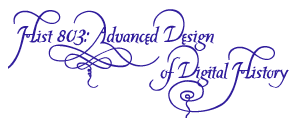Learning Experiences
PREPARING TO PHOTOGRAPH FOR QTVR
Based on playing with the digital video camera, I already knew I should test out the cameras that I would be borrowing from a friend before I headed down to Washington’s Birthplace to photograph their embroidered 18th-century petticoat.
It soon became apparent that in order to get the tripod placed to photograph in even increments around the object, I would have to pre-mark each spot on the floor, rather than measure as I went around the object. Using a strap, some tape, and my hand as a measuring device, I laid out my points along the circle. In executing the photos, I discovered that I need to take into account the space required for the tripod all the way around the object, if I'm going to move the tripod around it. I also realized that a rigid measuring device would have likely given me more precise results. Another problem seemed to arise from some frames in which the tripod was not placed “dead-on” and so caused the image to jump from one frame to the next.
Thank goodness for the pseudo-preview of the QTVR I got by cycling through the digital images. My strategy will be to use a lazy-susan to rotate the dress form so that the tripod can remain stationary for the photography. This requires constructing a lazy-susan platform that will hold a dress form, which, after a foray to the hardware store seems like it may be possible. The lazy-susan will have to have markings of even spacing (perhaps 5 degree intervals) so that it can be turned precisely the same amount each time I take a photo. As there won't be time to test before heading down to the Birthplace, I will bring a back up option, in case it does not work as expected. Pattern-Ez comes with a pre-marked grid on it, so I will be able to measure points on it and have a more precise placement of the tripod if it is necessary for me to move the tripod after all.
At this point it is not clear to me whether it will be necessary to trim the object out of each frame to produce the QTVR.
DIGITAL VIDEO
There is a lot to learn from doing technology tests. I started out trying to set things up in my improvised kitchen-studio so that if the footage actually worked, I could use it in my final project. Lesson 1: my kitchen is too small for a video studio. Fortunately I had a friend helping out who continuoulsy reminded me that what I was doing was a test, not the final product, that no matter what, I was going to be doing this again, and I should stop worrying about the picky details the first time out.
The process of going from idea, to recording, to editing taught me quite a bit about the value of a) simplicity, and b) variety. Keep the main concept simple, and provide yourself with a variety of raw footage, and something will come together in the editing process. Also, what you think you're recording may not be the story that you tell by the end of the editing process.
